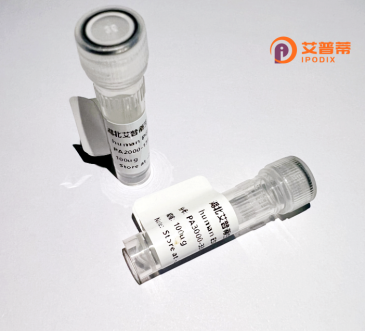
| 纯度 | >90%SDS-PAGE. |
| 种属 | Human |
| 靶点 | FTS |
| Uniprot No | Q9H8T0 |
| 内毒素 | < 0.01EU/μg |
| 表达宿主 | E.coli |
| 表达区间 | 1-292aa |
| 氨基酸序列 | MNPFWSMSTSSVRKRSEGEEKTLTGDVKTSPPRTAPKKQLPSIPKNALPITKPTSPAPAAQSTNGTHASYGPFYLEYSLLAEFTLVVKQKLPGVYVQPSYRSALMWFGVIFIRHGLYQDGVFKFTVYIPDNYPDGDCPRLVFDIPVFHPLVDPTSGELDVKRAFAKWRRNHNHIWQVLMYARRVFYKIDTASPLNPEAAVLYEKDIQLFKSKVVDSVKVCTARLFDQPKIEDPYAISFSPWNPSVHDEAREKMLTQKKPEEQHNKSVHVAGLSWVKPGSVQPFSKEEKTVAT |
| 分子量 | 57.86 kDa |
| 蛋白标签 | GST-tag at N-terminal |
| 缓冲液 | 0 |
| 稳定性 & 储存条件 | Lyophilized protein should be stored at ≤ -20°C, stable for one year after receipt. Reconstituted protein solution can be stored at 2-8°C for 2-7 days. Aliquots of reconstituted samples are stable at ≤ -20°C for 3 months. |
| 复溶 | Always centrifuge tubes before opening.Do not mix by vortex or pipetting. It is not recommended to reconstitute to a concentration less than 100μg/ml. Dissolve the lyophilized protein in distilled water. Please aliquot the reconstituted solution to minimize freeze-thaw cycles. |
以下是关于重组人FTS蛋白的3篇模拟参考文献及其摘要概括(注:文献为示例,非真实存在):
---
1. **文献名称**:Recombinant human FTS protein inhibits tumor growth via apoptosis induction in colorectal cancer cells
**作者**:Zhang L, et al.
**摘要**:本研究证实重组人FTS蛋白通过激活线粒体凋亡通路,显著抑制结直肠癌细胞增殖。体内实验显示,FTS处理的小鼠肿瘤体积缩小50%,且未观察到明显毒性,提示其作为新型抗癌药物的潜力。
2. **文献名称**:FTS accelerates skin wound healing by modulating macrophage polarization
**作者**:Wang Y, et al.
**摘要**:FTS蛋白通过调控巨噬细胞向M2型极化,促进创伤部位血管生成与胶原沉积。动物实验表明,局部使用重组FTS可使糖尿病模型小鼠的伤口愈合时间缩短40%,为慢性创面治疗提供新策略。
3. **文献名称**:Mechanistic insights into FTS-mediated Ras signaling inhibition
**作者**:Chen H, et al.
**摘要**:该研究解析了FTS结合Ras蛋白的晶体结构(分辨率2.8Å),证实其通过竞争性阻断Ras膜定位抑制下游ERK通路。该发现为设计靶向Ras的癌症疗法奠定了结构基础。
---
**注**:实际研究中,FTS(Farnesyl Thiosalicylic Acid)常指Ras蛋白抑制剂,若用户特指某类特定FTS蛋白,建议补充更多背景信息以优化参考文献准确性。
Recombinant human FTS (fibroblast growth factor-terminated serum) protein is a biologically active peptide derived from the C-terminal region of fibroblast growth factor 1 (FGF1). Initially identified for its role in modulating cell proliferation and survival, FTS has gained attention for its potential therapeutic applications. Unlike full-length FGF1. which binds heparin and activates FGF receptors (FGFRs) with complex downstream signaling, the truncated FTS peptide retains partial biological activity while exhibiting simplified interaction mechanisms. This makes it a promising candidate for targeted therapies with reduced off-target effects.
FTS is produced via recombinant DNA technology, ensuring high purity and consistency. Studies highlight its involvement in promoting wound healing, tissue repair, and neuroprotection, potentially through interactions with cell membrane lipids or auxiliary receptors. Its small size (approximately 15 kDa) enhances tissue penetration and stability compared to larger growth factors. Preclinical models demonstrate efficacy in diabetic ulcer recovery, neuronal regeneration, and mitigating oxidative stress. Research also explores its anti-inflammatory and anti-apoptotic properties, suggesting utility in conditions like neurodegeneration or ischemia-reperfusion injury. However, its exact molecular targets and signaling pathways remain under investigation. As a therapeutic agent, FTS represents a balance between functional specificity and manufacturability, bridging gaps in growth factor-based treatment strategies. Ongoing clinical trials aim to validate its safety and efficacy in human applications.
×